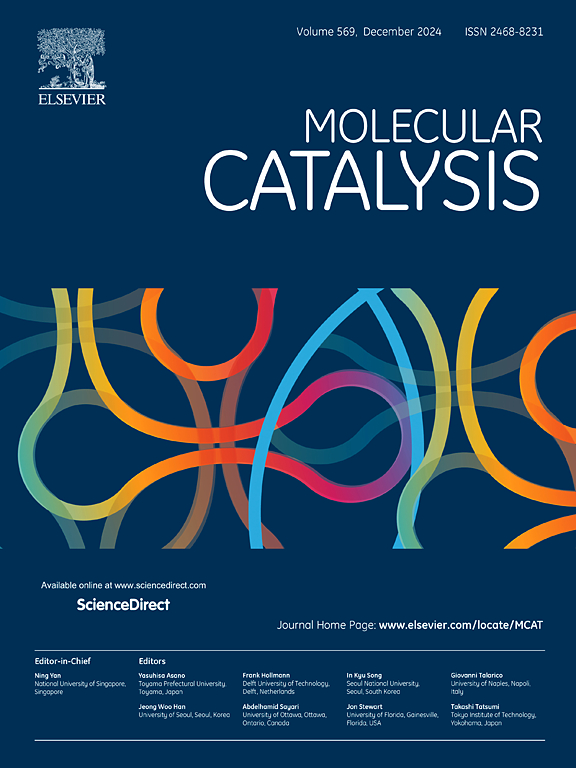The ring-opening polymerization of cyclic ester and carbonate catalyzed by trimethyl glycine and catalyst design: A DFT study
IF 3.9
2区 化学
Q2 CHEMISTRY, PHYSICAL
引用次数: 0
Abstract
Organic catalytic ring-opening polymerization (ROP) of cyclic esters and carbonates is an effective strategy for obtaining biodegradable and biocompatible aliphatic polyesters and polycarbonates. The challenge is to develop highly active and green organocatalysts in this domain. Herein, the zwitterionic carboxybetaine catalyzed the ROP mechanism of trimethylene carbonate (TMC) cyclic ester and lactide (LA) was investigated by density functional theory (DFT). By comparing the ROP of TMC catalyzed by natural trimethyl glycine (TMG) and unnatural tetramethylammonium acetate (TMAA), we found the proton-accepting ability of the anion part in zwitterionic carboxybetaine is the main influencing factor of polymerization activity. Based on this finding, it is proposed to enhance the proton-accepting ability of the anion part in TMG by extending carbon spacer lengths between CH3COO‒ and N(CH3)4+ of TMG. Among them zwitterionic carboxybetaine molecules ((CH3)3N+(CH2)nCOO‒ (n = 1–5)), the (CH3)3N+(CH2)4COO‒ shows the highest catalytic activity in the ROP of TMC. Moreover, the ROP of LA catalyzed by (CH3)3N+(CH2)4COO‒ showed very high catalytic activity compared to the TMG in both theoretical calculation and experiment. This work will inspire the future development of natural organocatalysts with high catalytic performance.

三甲基甘氨酸催化环酯与碳酸酯开环聚合及催化剂设计的DFT研究
环酯和碳酸酯的有机催化开环聚合(ROP)是获得可生物降解和生物相容性的脂肪族聚酯和聚碳酸酯的有效策略。目前面临的挑战是如何开发出高效、绿色的有机催化剂。采用密度泛函理论(DFT)研究了两性离子羧基甜菜碱催化碳酸三亚甲基环酯和丙交酯的ROP机理。通过比较天然三甲基甘氨酸(TMG)和天然四甲基乙酸铵(TMAA)催化的TMC的ROP,我们发现两性离子羧基甜菜碱阴离子部分的质子接受能力是影响聚合活性的主要因素。基于这一发现,我们提出通过延长TMG的CH3COO -和N(CH3)4+之间的碳间隔长度来增强TMG阴离子部分的质子接受能力。其中两性离子型羧甜菜碱分子((CH3)3N+(CH2)nCOO - (n = 1-5))中,(CH3)3N+(CH2)4COO -在TMC的ROP中表现出最高的催化活性。理论计算和实验结果表明,(CH3)3N+(CH2)4COO -催化的LA的ROP都比TMG具有很高的催化活性。这项工作将对未来开发具有高催化性能的天然有机催化剂有一定的启发作用。
本文章由计算机程序翻译,如有差异,请以英文原文为准。
求助全文
约1分钟内获得全文
求助全文
来源期刊

Molecular Catalysis
Chemical Engineering-Process Chemistry and Technology
CiteScore
6.90
自引率
10.90%
发文量
700
审稿时长
40 days
期刊介绍:
Molecular Catalysis publishes full papers that are original, rigorous, and scholarly contributions examining the molecular and atomic aspects of catalytic activation and reaction mechanisms. The fields covered are:
Heterogeneous catalysis including immobilized molecular catalysts
Homogeneous catalysis including organocatalysis, organometallic catalysis and biocatalysis
Photo- and electrochemistry
Theoretical aspects of catalysis analyzed by computational methods
 求助内容:
求助内容: 应助结果提醒方式:
应助结果提醒方式:


